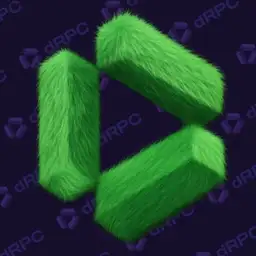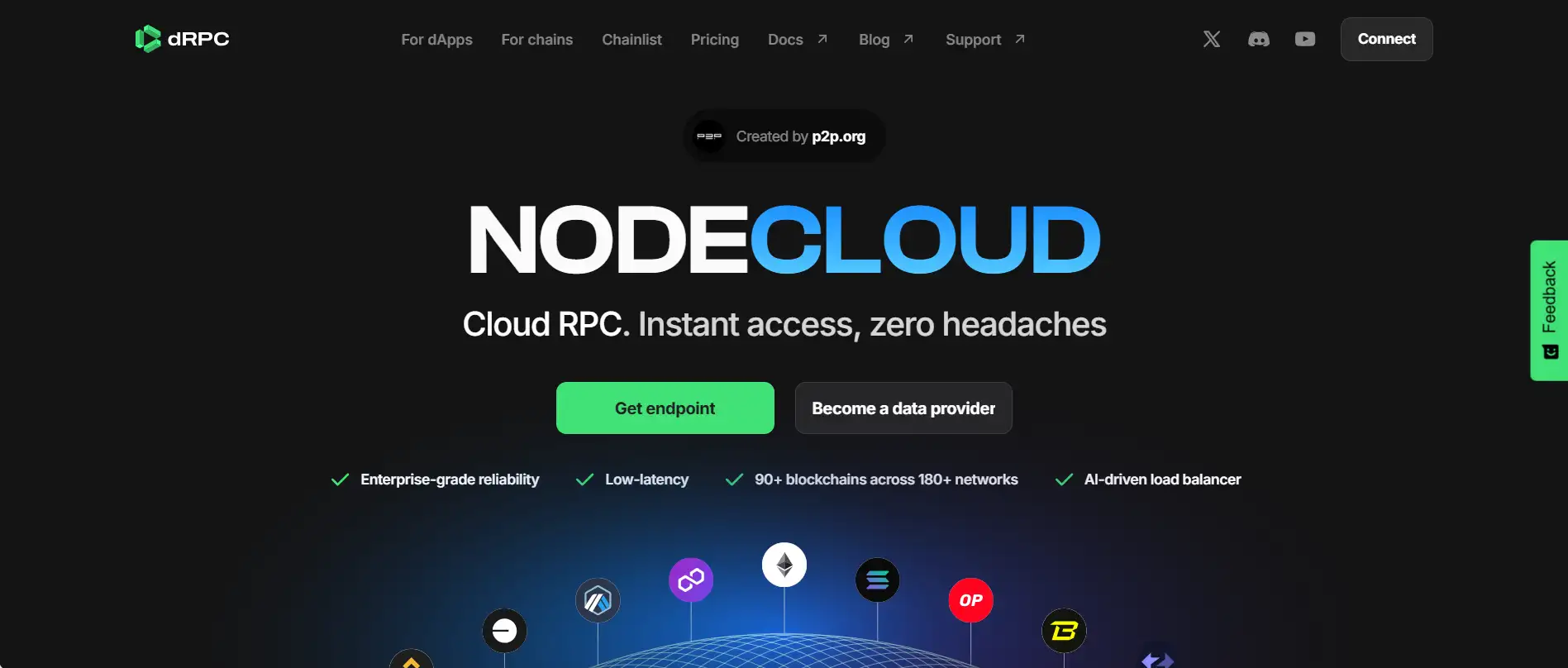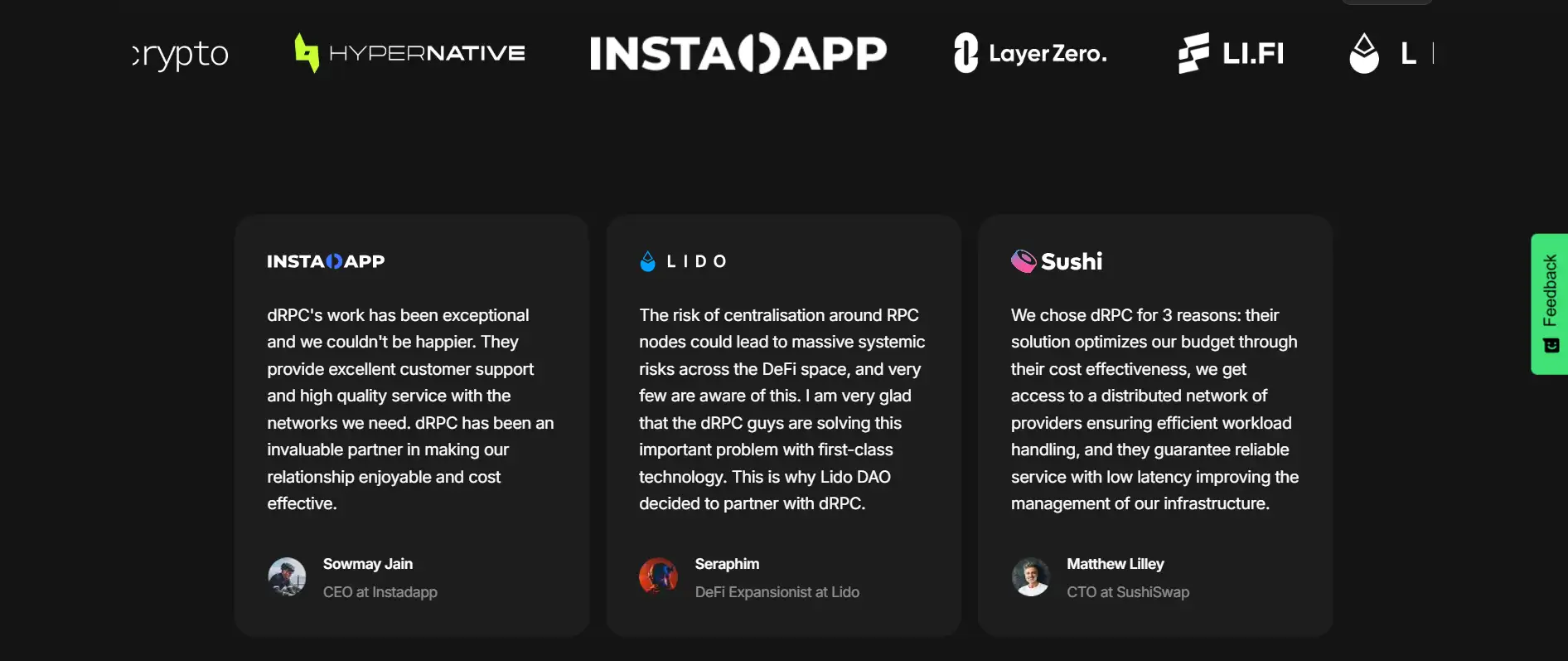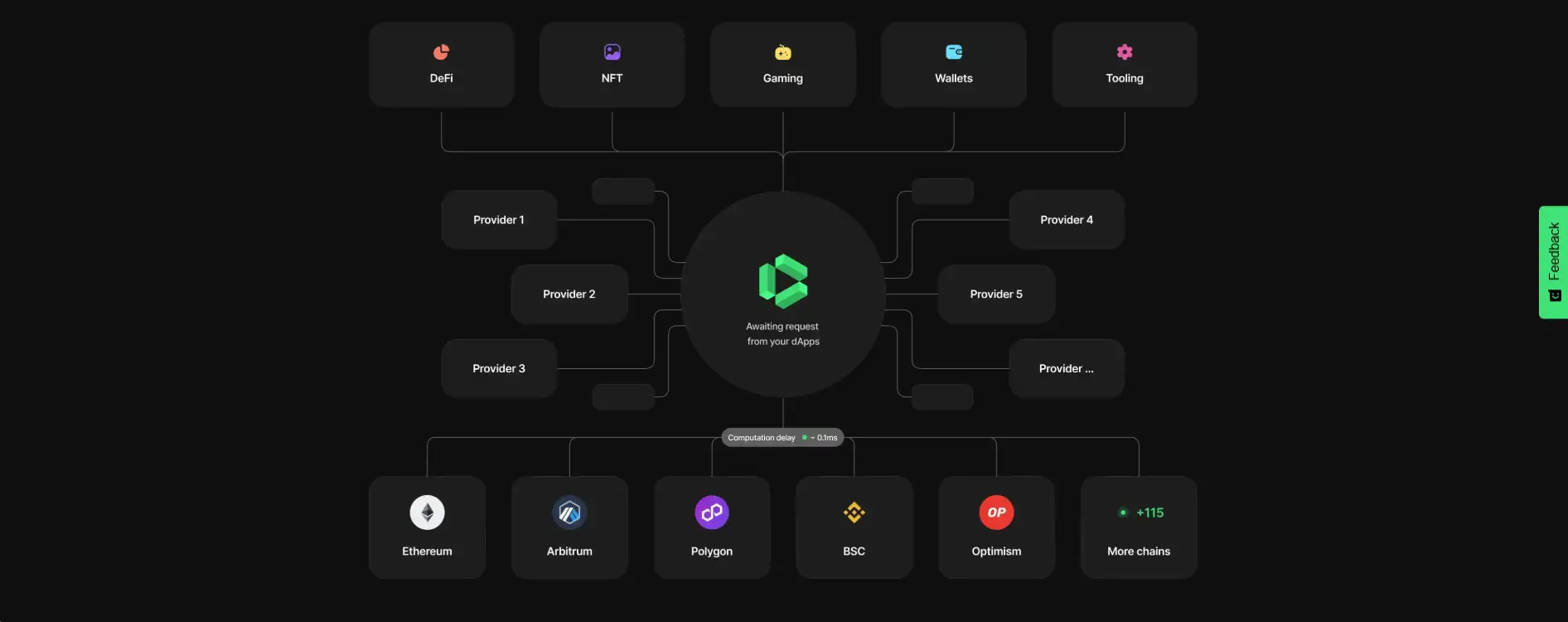About DRPC
dRPC is a next-generation Web3 infrastructure provider that offers high-performance, low-latency, and censorship-resistant access to blockchain networks via globally distributed RPC endpoints. Designed with a focus on decentralization, dRPC connects developers and enterprises to over 90+ blockchains across 180+ networks, enabling seamless integration without the overhead of managing nodes or providers.
Backed by P2P.org, the team behind dRPC has created a robust infrastructure that combines AI-driven load balancing, MEV protection, and advanced routing protocols to serve over 3 billion requests per day from more than 3,000 dApps. Whether you're building a DeFi protocol, a cross-chain application, or an NFT marketplace, dRPC ensures fast, reliable, and private access to blockchain data. It is trusted by top-tier Web3 projects like Instadapp, Lido DAO, and SushiSwap.
dRPC was created to address one of the most critical and often overlooked challenges in the Web3 ecosystem: reliable, scalable, and decentralized access to blockchain nodes. Since its launch, the platform has rapidly evolved into a leading infrastructure provider by leveraging its core architectural components—Dproxy and a customized fork of Dshackle. These systems work in tandem to optimize request routing, enhance failover resilience, and dynamically select the best node based on latency, health, and blockchain sync status.
At the heart of dRPC’s architecture is its unique approach to decentralization. Rather than operating a single provider network, dRPC aggregates services from a variety of independent infrastructure partners. Each partner runs its own instance of Dshackle, allowing dRPC to ensure that requests are only routed to fully-synced, healthy, and efficient nodes. This enables seamless load balancing, failover handling, and customized routing depending on the request—whether it's transaction submission, balance queries, or accessing specific block data.
The platform’s central gateway, Dproxy, ensures high performance and fairness by continuously evaluating provider performance using a real-time rating system. It considers factors such as latency, uptime, capacity, and recent usage to dynamically assign requests to the best possible provider. Dproxy also manages critical platform logic including user authorization, compute unit tracking, and API key permissions, allowing for scalable use across teams and organizations.
dRPC also leads with privacy and protection. Its Privacy Shield ensures user IP addresses are only used for routing, not logged or tracked. At the same time, it features built-in MEV protection to defend against front-running attacks, integrating directly with services like Flashbots, MEVBlocker, and bloXroute. This makes dRPC a secure, performance-driven platform capable of serving over 3 billion requests per day.
Comparable platforms such as Infura, Alchemy, and Chainstack offer similar node access, but dRPC distinguishes itself with its emphasis on decentralization, dynamic routing, open-source integrations, and its commitment to community-powered infrastructure. As a result, dRPC is quickly becoming the go-to choice for developers and enterprises building resilient, scalable applications in the decentralized web.
dRPC provides a wide range of benefits and features that make it a top-tier choice in the Web3 infrastructure space:
- Enterprise-Grade Reliability: dRPC routes requests across a globally distributed network of over 50+ providers to ensure uptime, low latency, and resilience against node failure.
- One Endpoint for 90+ Chains: Access Ethereum, Solana, Arbitrum, zkSync, and more using a single, load-balanced RPC endpoint with no setup required.
- AI-Driven Load Balancing: Intelligent routing ensures every request is sent to the best-performing node based on location, node health, sync status, and latency.
- MEV & Front-running Protection: Built-in defenses using Flashbots, MEVBlocker, and bloXroute prevent sandwich attacks at the RPC level, increasing transaction security.
- Privacy by Design: User IP addresses are only used for optimal routing and are never stored or exposed to providers, ensuring maximum privacy.
- Pay-as-You-Go Pricing: Flexible plans starting at $6 per million requests, with no monthly commitments or hidden fees. Free tier available for public endpoints.
- Team Access & Role Management: Invite your team, assign permissions, and manage access with unlimited API keys and advanced usage controls.
- Advanced Analytics: Monitor usage, request patterns, and performance metrics in real-time with developer-friendly dashboards.
Getting started with dRPC is quick and developer-friendly, making it accessible for both individuals and teams:
- Visit the official website: Go to drpc.org to explore plans, supported networks, and technical documentation.
- Create a free account: Sign up and gain access to a personal dashboard with a free monthly tier of 210M compute units and access to public RPC endpoints.
- Generate your API key: Instantly generate one or more API keys to integrate dRPC endpoints into your dApp, tool, or backend service.
- Start making requests: Use the unified RPC endpoint to interact with over 90 supported blockchains. No configuration needed—just plug and play.
- Explore documentation: Access full technical documentation and integration examples at the dRPC Docs portal.
- Monitor performance: Use built-in analytics tools to track request volume, latency, errors, and API usage.
- Upgrade as needed: Move to the Growth or Enterprise tier when your usage grows. Contact the team via the custom pricing form for high-volume or tailored needs.
- Join the community: Connect with developers and providers via dRPC’s social channels and stay updated via their blog and newsletter.
DRPC FAQ
dRPC achieves decentralization by aggregating independent node operators—each running their own infrastructure—into a unified network. It uses its own fork of Dshackle to route requests in real time based on node health, latency, chain height, and sync status. Unlike centralized RPC providers, dRPC distributes load across multiple providers while still maintaining enterprise-grade performance and uptime across 90+ supported blockchains.
Unlike most RPC services that leave MEV protection to wallets or dApps, dRPC builds protection into the RPC layer itself. By integrating directly with Flashbots, MEVBlocker, and bloXroute, transactions are automatically routed through privacy-preserving networks. This protects users from front-running and sandwich attacks, especially on chains like Solana where MEV is notoriously aggressive. It's a proactive, user-first approach to transaction security.
dRPC offers a transparent and flexible pricing model ideal for startups and scaling teams. The Pay-As-You-Go plan starts at just $6 per million requests with no overages or hidden fees. A generous free tier with 210M compute units per month is also available for builders using public nodes. This approach ensures that both hobbyists and enterprise developers can access world-class RPC infrastructure without financial pressure.
dRPC uses a modified version of Dshackle because the standard version doesn’t offer the fine-grained routing logic and performance analytics required at dRPC’s scale. Their fork allows custom prioritization of nodes based on method types—for example, using different nodes for transaction submissions vs. balance queries. It also ensures only fully-synced, high-performance nodes are selected, which guarantees faster and more accurate data delivery across all chains.
Dproxy is the heart of dRPC’s architecture, acting as a smart gateway that receives every request and selects the best provider to handle it. It evaluates each provider’s status in real-time, scores their reliability and speed, and routes traffic accordingly. Dproxy also manages user authentication, compute unit tracking, and team access control, enabling both transparency and scalability in how dRPC serves over 3 billion requests daily.
You Might Also Like












